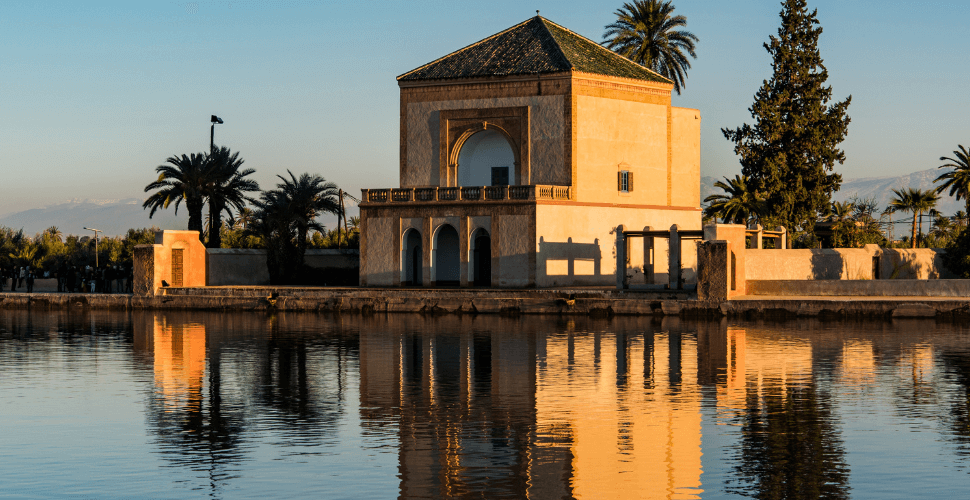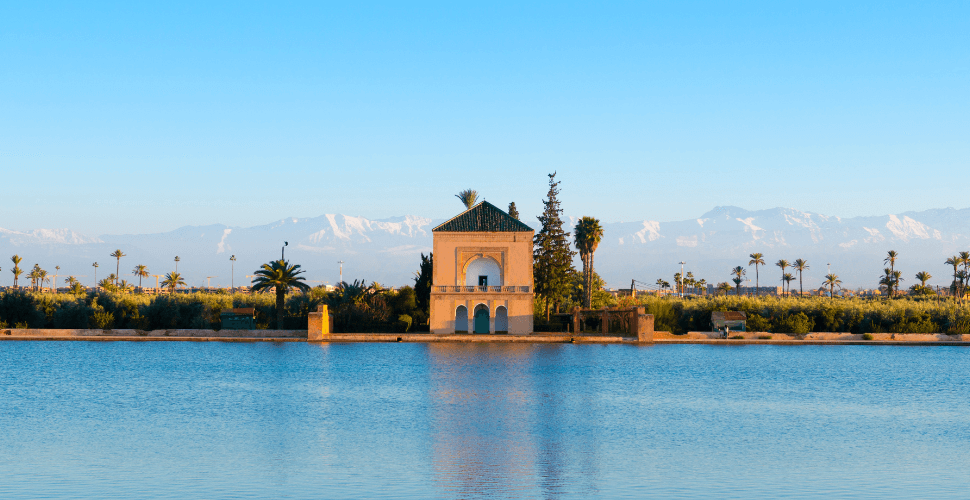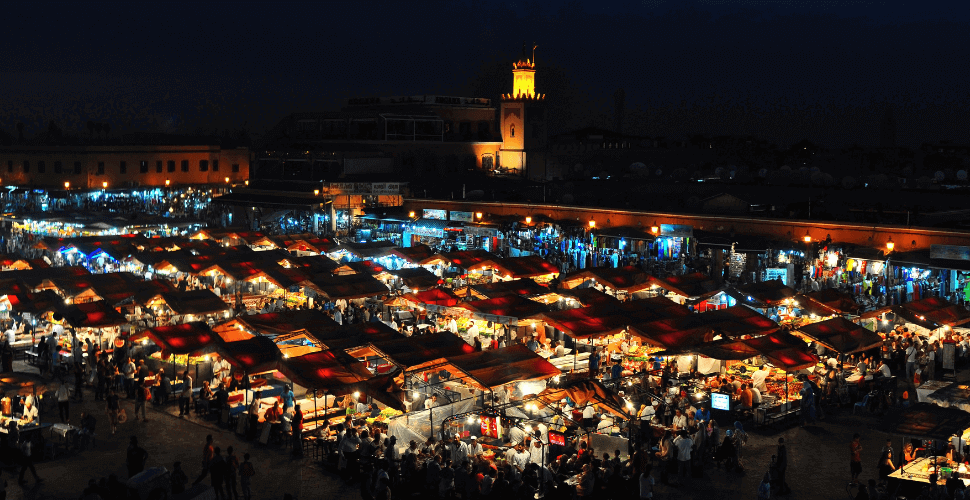La Koutoubia is a historical landmark in Marrakech, Morocco. It was built during the Almohad dynasty in the 12th century and has since become an iconic symbol of Moroccan culture. The name “Koutoubia” comes from the Arabic word for bookseller, as it was once located near a souk where books were sold.
Aside from its architectural significance, La Koutoubia holds great cultural importance to Moroccans. It serves as a reminder of their rich history and heritage, as well as their devotion to Islam. The mosque has been used for centuries by locals to worship and pray together, creating a sense of community amongst them.
Over time, La Koutoubia has undergone several renovations and restorations to preserve its beauty and structural integrity. Despite these changes, it remains one of the most recognizable landmarks in Morocco that attracts visitors from all over the world who come to appreciate its historical value and artistic design.

The architectural design of La Koutoubia and how it reflects Islamic art

The architectural design of La Koutoubia is a testament to the intricate and detailed nature of Islamic art. The mosque’s exterior features intricate geometric patterns, calligraphy, and tile work that are common in Islamic architecture. These designs are not just for aesthetic purposes but also have symbolic meanings rooted in Islam.
One example of this symbolism can be seen in the horseshoe arches that frame the entrance to the prayer hall. This type of arch was commonly used during the Moorish period in Spain and is believed to represent a gateway to paradise. Additionally, the minaret’s shape reflects traditional Moroccan architecture with its square base tapering into an octagonal structure topped with a spire.
Inside La Koutoubia, visitors will find more examples of Islamic art reflected in its architectural design. The prayer hall features intricately carved wooden screens called mashrabiyas that were traditionally used as privacy screens for women during worship. These screens allow light to filter through while still maintaining some level of privacy for worshippers.
Overall, La Koutoubia’s architectural design showcases how Islamic art incorporates both form and function into its structures while also incorporating symbolic elements important to Muslim culture and beliefs.
The intricate details of the exterior of La Koutoubia
The exterior of La Koutoubia is a stunning display of Islamic architecture. The red sandstone walls are adorned with intricate carvings and geometric patterns, showcasing the attention to detail that went into its construction. The main entrance features horseshoe arches and a large wooden door, adding to the grandeur of the building.
One notable feature on the exterior is the rows of small windows near the top of the mosque. These are known as muqarnas, which are decorative elements often found in Islamic architecture. They create an illusion of depth and add texture to what would otherwise be a flat surface.
Another impressive aspect is the minaret, standing at over 70 meters tall. It has three tiers with ornate decorations including calligraphy and floral motifs. The top tier features a lantern dome with pointed arches and intricate details carved into it. This iconic symbol can be seen from various points throughout Marrakech and serves as a reminder of Morocco’s rich cultural heritage.

The grandeur of the interior of La Koutoubia

The interior of La Koutoubia is just as impressive as its exterior. The prayer hall, which can accommodate up to 25,000 worshippers, is adorned with intricate geometric patterns and calligraphy that cover the walls and ceilings. The use of Islamic art in the design creates a serene atmosphere that inspires contemplation and reflection.
One of the most striking features of the interior is the horseshoe-shaped mihrab, a niche indicating the direction of Mecca towards which Muslims pray. It is made from marble and surrounded by ornate decoration in gold leaf. Above it hangs an exquisite chandelier made from brass and glass beads that illuminates the space with soft light.
Visitors will also notice several domes throughout the prayer hall that allow natural light to filter through stained-glass windows creating beautiful colors on the floor below. These domes are decorated with elaborate plasterwork designs featuring floral motifs and Arabic calligraphy. The overall effect is one of grandeur mixed with serenity making La Koutoubia a must-visit destination for anyone interested in Islamic art or architecture.
The iconic minaret of La Koutoubia and its symbolism
The minaret of La Koutoubia is undoubtedly the most iconic feature of this historical mosque. It stands at an impressive height of 77 meters and can be seen from almost any point in Marrakech. The design of the minaret reflects traditional Islamic architecture, with its square base, octagonal shaft, and decorative elements such as calligraphy and geometric patterns.
Symbolically, the minaret represents a connection between earth and heaven. Its towering presence serves as a reminder to Muslims that they are never alone in their faith – Allah is always watching over them from above. Additionally, the shape of the minaret itself has been said to represent a finger pointing towards heaven, indicating the direction in which Muslims should pray.
Interestingly enough, there is also a legend surrounding the construction of La Koutoubia’s minaret. According to local folklore, when Sultan Yacoub al-Mansour commissioned its construction in 1184 AD, he instructed his architects to build it higher than any other structure in Marrakech at that time. However, upon completion it was discovered that one stone had been placed upside down near the top of the tower – rendering it slightly shorter than intended! Despite this mishap (or perhaps because of it), La Koutoubia’s minaret remains an awe-inspiring sight for all who visit it today.

The role of La Koutoubia in Islamic worship and its accessibility to non-Muslims

La Koutoubia is one of the most important mosques in Morocco, and it holds a significant role in Islamic worship. The mosque has been a place of prayer for Muslims for over 800 years, and it continues to be an active center of religious activity today. Every day, thousands of worshippers gather at La Koutoubia to perform their daily prayers.
Despite its importance as a place of Islamic worship, La Koutoubia is also accessible to non-Muslims. Visitors are welcome to explore the mosque’s exterior architecture and surrounding gardens during certain hours throughout the week. However, access inside the mosque is restricted only to Muslims during prayer times.
Nonetheless, visitors can still appreciate the beauty and grandeur of La Koutoubia from outside – including its iconic minaret that has become a symbol of Marrakech city itself. For those interested in learning more about Islam or Moroccan culture, there are guided tours available which provide insight into both aspects while respecting religious practices within the mosque premises.
The surrounding gardens of La Koutoubia and their beauty
The gardens surrounding La Koutoubia are a true oasis in the heart of Marrakech. With lush greenery, colorful flowers, and fountains that provide soothing sounds, visitors can escape from the hustle and bustle of the city. The serene atmosphere is perfect for those seeking a moment of tranquility.
One of the most stunning features of the gardens is their symmetry. The paths are meticulously laid out in geometric patterns, creating an aesthetically pleasing view from every angle. In addition to this visual appeal, there are also several seating areas throughout the gardens where visitors can relax and take it all in.
As you walk through the gardens, you’ll notice many different types of trees and plants native to Morocco. From palm trees to cacti to blooming roses, each section has its own unique charm. It’s no wonder why so many locals come here for picnics or simply to enjoy a peaceful afternoon stroll amidst nature’s beauty.

The impact of La Koutoubia on the city of Marrakech and its tourism industry
La Koutoubia is undoubtedly one of the most significant landmarks in Marrakech, and its impact on the city’s tourism industry cannot be overstated. The mosque attracts visitors from all over the world who come to admire its stunning architecture and learn about Islamic culture. As a result, La Koutoubia has become an essential part of Marrakech’s identity and has helped put the city on the map as a must-visit destination.
The mosque’s influence extends beyond just attracting tourists; it also plays a vital role in supporting local businesses. Many shops, restaurants, and hotels have sprung up around La Koutoubia to cater to visitors’ needs, creating jobs for locals and boosting Marrakech’s economy. Additionally, many tour companies offer guided tours that include visits to La Koutoubia, providing another source of income for those in the tourism industry.
Despite its popularity among tourists, La Koutoubia remains an important place of worship for Muslims. The mosque is open only to worshippers during prayer times but allows non-Muslims to explore its grounds outside these hours. This balance between accessibility and respect for religious traditions highlights Morocco’s commitment to promoting cultural understanding while preserving its heritage sites’ sanctity.

The preservation efforts and restoration projects of La Koutoubia

La Koutoubia has been a significant landmark in Marrakech for over 800 years, and as such, it requires ongoing preservation efforts. The Moroccan government has allocated funds to ensure that the mosque remains structurally sound and aesthetically pleasing. In recent years, restoration projects have focused on repairing damaged stonework, refurbishing intricate tile work, and enhancing the lighting system.
One of the most notable restoration projects was completed in 2018 when the minaret underwent extensive cleaning and repair work. The delicate plasterwork was carefully restored to its former glory using traditional techniques by skilled craftsmen from Marrakech. The project also included installing new LED lights at the top of the minaret to illuminate it at night.
In addition to these physical preservation efforts, La Koutoubia’s management team is committed to educating visitors about its history and cultural significance through guided tours and exhibits within the mosque complex. These initiatives aim to promote an appreciation for Islamic art and architecture while preserving this iconic monument for future generations to enjoy
Personal experiences and recommendations for visiting La Koutoubia.
When visiting La Koutoubia, it’s important to dress modestly and respectfully as it is a religious site. The mosque is open to non-Muslim visitors, but only during certain hours of the day. It’s best to check the schedule beforehand and plan accordingly.
Once inside, take your time exploring the intricate details of the interior. The prayer hall is vast and beautifully decorated with colorful tiles, carved woodwork, and ornate chandeliers. It’s a peaceful space that exudes a sense of calmness.
After admiring the mosque itself, don’t forget to take a stroll through its surrounding gardens. The lush greenery provides a refreshing escape from Marrakech’s bustling city center. You can even enjoy some mint tea or traditional Moroccan pastries at one of the small cafes located within the garden grounds for an authentic experience.

Unleash the Adventure: Discover Our Excursions
Please note that every route listed on our website is simply a starting point. At our company, we believe in fully customizing every aspect of your trip to meet your specific timing, budget, and preferences. We offer complete flexibility to extend, adjust, shorten, add or even skip stops and towns within a reasonable frame.
Our team of experts will work with you to recommend the best routes and schedules that cater to your interests and create an efficient yet comfortable itinerary. Trust us to take care of all the details, so you can sit back, relax and enjoy your personalized travel experience.










